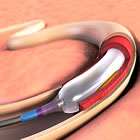|
"This exciting milestone keeps us on track for FDA approval of the IN.PACT Admiral drug-coated balloon in the U.S. in early FY16," reaffirmed Tony Semedo, president of Medtronic's endovascular therapies business. "More than 1,000 patients have been enrolled in the studies submitted to the FDA. The breadth and depth of our clinical program is unparalleled in the treatment of femoropopliteal disease across both randomized, controlled trials and real-world studies." The final PMA module includes landmark pivotal data recently presented at Charing Cross and EuroPCR annual meetings from the IN.PACT SFA Trial, investigating IN.PACT Admiral for the treatment of peripheral artery disease in the superficial femoral artery (SFA) or proximal popliteal artery (both located in the leg above the knee), compared to standard balloon angioplasty. At 12 months follow-up, both primary endpoints showed a highly statistically significant difference between treatment groups:
Also included in the application is new data from the first 650 patients in the IN.PACT Global study, a first-of-its-kind, "real-world" 1,500-patient evaluation of the IN.PACT Admiral drug-coated balloons for the treatment of femoropopliteal lesions providing important data about more complex anatomical and clinical patient characteristics. "The introduction of drug-coated balloons in the U.S. for the treatment of peripheral artery disease in the SFA is highly anticipated as a new standard of care for this difficult to treat condition, especially due to the consistently strong clinical data we've witnessed with IN.PACT Admiral," said John Laird, M.D., co-principal investigator of IN.PACT SFA, and interventional cardiologist, U.C. Davis Medical Center, Calif. "The IN.PACT Admiral clinical program has raised the bar for the industry, and may reduce the need for traditional interventions as first-line treatment, such as metal stents, which are not ideally suited for this dynamic artery." Peripheral artery disease is a growing problem globally, affecting an estimated eight to 12 million people in the United States alone and is characterized by the accumulation of fatty deposits, or plaque, in the body's arteries that carry blood to the extremities. In the legs, this condition can cause severe pain in calf muscles while walking resulting in functional and quality of life impairment, a condition known as claudication. Critical limb ischemia is a more serious form of peripheral artery disease and is associated with pain at rest and ischemic ulcers or gangrene leading to an increased risk of limb loss and premature death. Approximately 450,000 people in the U.S. undergo an interventional procedure each year for peripheral artery disease in the SFA, the most common form of the condition. The SFA runs close to the surface of the upper leg, from the groin to the knee and is subject to the most intense dynamic forces such as torsion and compression, which pose inherent challenges for permanent metallic stents. IN.PACT Admiral drug-coated balloons leave no scaffolding behind in the SFA, unlike stents, which are permanently implanted to keep the artery propped open. A proprietary coating called FreePac, a formulation of the antiproliferative drug paclitaxel and the natural excipient urea, facilitates rapid absorption of the drug into the vessel wall and prevents excess scar tissue from forming along the wall of the treated arterial segment. The IN.PACT Admiral drug-coated balloon received the CE (Conformité Européene) mark in 2009 but remains an investigational medical device in the U.S., where it is under review by the U.S. Food and Drug Administration (FDA). No drug-coated balloon has yet received FDA approval. With a combination of physician-initiated and company-sponsored studies, the ongoing global clinical program of IN.PACT drug-coated balloons for the treatment of peripheral artery disease in the lower extremities involves more than 4,200 patients across 24 studies worldwide. In collaboration with leading clinicians, researchers and scientists, Medtronic offers the broadest range of innovative medical technology for the interventional and surgical treatment of cardiovascular disease and cardiac arrhythmias. The company strives to offer products and services that deliver clinical and economic value to healthcare consumers and providers worldwide. About Medtronic Any forward-looking statements are subject to risks and uncertainties such as those described in Medtronic's periodic reports on file with the Securities and Exchange Commission. Actual results may differ materially from anticipated results. Source: Medtronic, Inc. |

